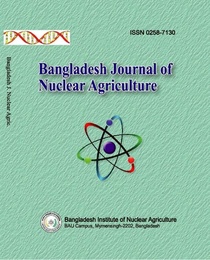COMPARATIVE PERFORMANCE OF INDIGENOUS AND EXOTIC RHIZOBIAL STRAINS ON THE GROWTH AND YIELD OF LENTIL
Abstract
Rhizobia, the Gram negative soil bacteria, form root nodules with lentil and influence its growth and yield. We evaluated the ability of the selected rhizobial strains on growth and yield of lentil at high Ganges river floodplain soils of Bangladesh under field conditions. The field experiment included nine treatments- three indigenous rhizobial strains (BLR26, BLR175 and BLR235), two exotic strains (nifTAL638 and nifTAL640), two mixed cultures, one fertilizer-nitrogen treatment and a control. Lentil seeds were inoculated with rhizobial strains as per the treatments and planted. Inoculation of lentil with indigenous strains BLR26 and BLR175 recorded higher grain yields over all other treatments except fertilizer-nitrogen application. Inoculation of indigenous mixed strains also resulted significantly higher lentil grain yield over the exotic strains. Thus, indigenous strains BLR26 and BLR175 can be used for lentil cultivation for improving nodulation, growth and yield of lentil at high Ganges river floodplain soils of Bangladesh.
References
Ballard, R.A., Craig, A.D. and Charman, N. 2002. Nodulation and growth of pasture legumes with naturalised soil rhizobia. Balansa clover (Trifolium michelianum Savi). Aust. J. Exp. Agric. 42:939–44.
Burdon, J.J., Gibson, A.H., Searle, S.D., Woods, M.J. and Brockwell, J. 1999. Variation in the effectiveness of symbiotic associations between native rhizobia and temperate Australian Acacia: within-species interactions. J. Appl. Ecol. 36:398–408.
Denton, M. D., Coventry, D.R., Bellotti, W.D. and Howieson, J.G. 2000. Distribution, abundance and symbiotic effectiveness of Rhizobium leguminosarum bv. trifolii from alkaline pasture soils in South Australia. Aust. J. Exp. Agric. 40:25–35.
Fåhreus, G. 1957. The infection of clover root hairs by nodule bacteria studied by a simple glass slide technique. J. Gen. Microbiol. 16: 374 – 381.
FAOSTAT-Agriculture. 2010. Food and agricultural commodities production. Food and agriculture organization. Rome.
FRG, 2012. Fertilizer recommendation guide, Bangladesh Agricultural Research Council (BARC), Farmgate, Dhaka-1215. p.274
Gan, Y. and Mcdonald, C.L. 2002. Chickpea genotype population canopy study. Dryland Cropping Systems Field Day, Swift Current, SK. 4: 11-15.
Glick, B.R. 2012. Plant growth-promoting bacteria: mechanisms and applications. Scientifica doi 10.6064/2012/963401.
Gomez, K.A. and Gomez, A.A. 1984. Statistical procedures for Agricultural Research. 2nd edition. Jhon Wiely and Sons, New York, pp. 207-215.
Heath, K.D. and Tiffin, P. 2007. Context dependence in the coevolution of plant and rhizobial mutualists. Proc. R. Soc. 274:1905–12.
Ibáñez, F., Angelini, J., Taurian, T., Tonelli, M.L. and Fabra, A. 2009. Endophytic occupation of peanut root nodules by opportunistic Gammaproteobacteria. Syst. Appl. Microbiol. 32:49-55. doi: 10.1016/j.syapm.2008.10.001
McKenzie, R.H., Middleton, A.B., Solberg, E.D., DeMulder, A.B., Flore, N., Clayton, G.W. and Breme, E. 2001. Response of pea to rhizobia inoculation and starter nitrogen in Alberta. Candian J. Plant Sci. 81: 637-643.
Perret, X., Staehelin, C. and Broughton, W.J. 2000. Molecular basis of symbiotic promiscuity. Microbiol. Mol. Biol. Report 64: 180– 201.
Ratcliff, W.C., Kadam, S.V.and Denison, R.F. 2008. Poly-3-hydroxybutyrate (PHB) supports survival and reproduction in starving rhizobia. FEMS Microbiol. Ecol. 65: 391–399.
Rashid, M.H., Sattar, M.A., Uddin, M.I. and Young, J.P.W. 2009. Molecular characterization of symbiotic root nodulating rhizobia isolated from lentil. EJEAF Che. 8: 602-612.
Rashid, M.H., Schafer, H., Gonzalez, H. and Wink, M. 2012. Genetic diversity of rhizobia nodulating lentil (Lens culinaris) in Bangladesh. Syst. Appl. Microbiol. 35:98-109.
Rashid, M.H., Gonzalez, H., Young, J.P.W. and Wink, M. 2014. Rhizobium leguminosarum is the symbiont of lentil in the Middle East and Europe but not in Bangladesh. FEMS Microbiol. Ecol. 87: 64 -77.
Rashid, MH., Young, J.P.W., Everall, I., Clercx, P., Willems, A., Braun, M.S. and Wink, W. 2015. Average nucleotide identity of genome sequences supports the description of Rhizobium lentis sp. nov., Rhizobium bangladeshense sp. nov. and Rhizobium binae sp. nov. from lentil (Lens culinaris) nodules. Inter. J. Syst. Evol. Microbiol. 65:3037-3045.
Rahman, M.M., Bakr, M.A., Mia, M.F., Idris, K.M., Gowda, C.L.L., Kumar, J., Deb, U.K., Malek, M.A. and Sobhan, A. 2009. Legumes in Bangladesh. ICARDA, Patancheru, Andhra Pradesh, India.
Somasegaran, P. and Hoben, H.J. 1994. Handbook for rhizobia: methods in legume-rhizobium technology. Springer, Heidelberg.
Thrall, P.H., Slattery, J.F., Broadhurst, L.M. and Bickford, S. 2007 Geographic patterns of symbiont abundance and adaptation in native Australian Acacia-rhizobia interactions. J. Ecol. 95:110-1122
Vance, C.P. 2001. Symbiotic nitrogen fixation and phosphorus acquisition. Plant nutrition in a world of declining renewable resources. Plant Physiol. 127: 390-397.
Vessy, J.K. 2004. Benefits of inoculating legume crops with rhizobia in the northern Great Plains. Online. Crop Management. doi: 10.1094/ CM-2004-0301-04-RV.
Vincent, J.M. 1970. A Manual for the Practical Study of Root Nodule Bacteria. Oxford: Blackwell Scientific.
-
Download



